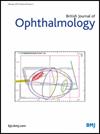Carbon dioxide laser excision as a novel treatment for large xanthelasma palpebrarum: long-term efficacy and safety
IF 3.7
2区 医学
Q1 OPHTHALMOLOGY
引用次数: 0
Abstract
Aims This study evaluates the long-term efficacy and safety of carbon dioxide (CO₂) laser excision as a novel treatment for large xanthelasma palpebrarum. Methods The study included 295 patients diagnosed with xanthelasma palpebrarum, categorised as 246 patients with grade I, 16 with grade II, 22 patients with grade III and 11 with grade IV lesions. All underwent CO₂ laser excision and were followed up for a 12-month period. Treatment efficacy was assessed through clearance and recurrence rates, evaluated using digital photography and complications were recorded. Results The participant group consisted of 66 males and 229 females, with an average age of 41.7±11.6 years. Clearance rates exceeded 99% for grades I–III and were around 95% for grade IV lesions. The recurrence rate was 6.8%, with higher recurrence rates observed in lesions over 2 mm in height compared with those under 2 mm (p<0.001). The main complications over the 12-month follow-up were scarring (4.4%), hyperpigmentation (8.1%) and hypopigmentation (8.5%), with no severe complications reported. Conclusion CO₂ laser excision emerges as a precise, minimally invasive and effective modality for treating xanthelasma palpebrarum, marking a significant advancement in treatment modalities. Further research is required to reinforce these results and refine treatment protocols. Data are available on reasonable request. The data including deidentified participant photographs are available on reasonable request (wangdq5@mail2.sysu.edu.cn).二氧化碳激光切除术作为治疗大面积睑黄褐斑的新疗法:长期疗效和安全性
目的 本研究评估了二氧化碳(CO₂)激光切除术作为治疗大面积睑黄褐斑新方法的长期疗效和安全性。方法 该研究纳入了 295 名确诊为睑黄褐斑的患者,分为 246 名 I 级患者、16 名 II 级患者、22 名 III 级患者和 11 名 IV 级患者。所有患者都接受了 CO₂ 激光切除术,并接受了为期 12 个月的随访。治疗效果通过清除率和复发率进行评估,使用数码照片进行评估,并记录并发症。结果 参试者包括 66 名男性和 229 名女性,平均年龄为(41.7±11.6)岁。I-III级病灶的清除率超过99%,IV级病灶的清除率约为95%。复发率为 6.8%,高度超过 2 毫米的病灶复发率高于高度低于 2 毫米的病灶(P<0.001)。随访 12 个月的主要并发症是瘢痕(4.4%)、色素沉着(8.1%)和色素减退(8.5%),没有严重并发症的报告。结论 CO₂激光切除术是治疗睑黄褐斑的一种精确、微创、有效的方法,标志着治疗方法的重大进步。要巩固这些成果并完善治疗方案,还需要进一步的研究。如有合理要求,可提供相关数据。如提出合理要求,可提供数据(包括去身份化的参与者照片)(wangdq5@mail2.sysu.edu.cn)。
本文章由计算机程序翻译,如有差异,请以英文原文为准。
求助全文
约1分钟内获得全文
求助全文
来源期刊
CiteScore
10.30
自引率
2.40%
发文量
213
审稿时长
3-6 weeks
期刊介绍:
The British Journal of Ophthalmology (BJO) is an international peer-reviewed journal for ophthalmologists and visual science specialists. BJO publishes clinical investigations, clinical observations, and clinically relevant laboratory investigations related to ophthalmology. It also provides major reviews and also publishes manuscripts covering regional issues in a global context.
文献相关原料
| 公司名称 | 产品信息 | 采购帮参考价格 |
|---|

 求助内容:
求助内容: 应助结果提醒方式:
应助结果提醒方式:


